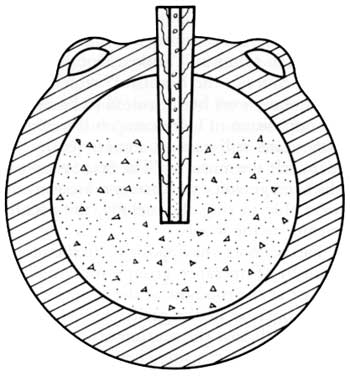|
FORT McHENRY National Monument and Historic Shrine |
 |

Cross section of 13-inch bomb.
British Bombs
The bombs and rockets which are commemorated in our national anthem were not the creation of a poet's imagination. In 1814, the bomb was the most potent weapon and the rocket the most spectacular in Britain's naval arsenal. Contemporary accounts bear witness to the profound impression which these missiles made upon the residents of Baltimore as they apprehensively witnessed the attack on Fort McHenry.
The massive bombs hurled against the fort were gradually developed from the crude hand grenade and primitive incendiary carcass. By 1814, they were the chief naval weapon employed against fixed shore installations. The bomb was a hollow, cast-iron sphere up to 13 inches in diameter, which, according to Falconer, "destroys the most substantial buildings by its weight, and, bursting asunder, creates the greatest disorder and mischief by its splinters." A 13-inch bomb weighed about 190 pounds and had walls 1.5 inches thick. It carried a bursting charge of about 9 pounds of powder. The amount of powder varied, depending on the type of fragmentation desired.
The fuse which ignited the bomb was a simple tapered piece of wood, 8.52 inches long. A channel was drilled lengthwise through the wood and packed with finely mealed powder.
To prepare the bomb for firing, it was necessary to pour the proper amount of powder into the bomb through the fuse hole. A fuse was then driven tightly into the hole, care being taken to avoid splitting the wood. The burning time of the fuse was regulated by cutting back on its lower end.
The bomb was fired by a short, heavy, muzzle-loading mortar which weighed over 8,000 pounds. With a full powder charge and elevated to 45°, it was capable of hurling a bomb 4,200 yards (2.38 miles). The piece rested on a massive bed or carriage which, in turn, was supported by powerful upright timbers. The bed could be rotated in traverse by handspikes.
To fire the weapon, a charge was inserted, then a wad, and lastly the bomb. Earth was usually packed between the bore of the weapon and the missile to make it fit tighter and thus increase the range. The gunner then pricked the powder charge, inserted a primer into the touch-hole of the mortar, and, upon receiving the order to fire, applied a slow match or portfire to the primer. The resulting explosion both ignited the fuse and discharged the bomb. A more certain but slightly more hazardous method was to load the bomb so that the fuse could be lit separately before the mortar was fired.
Since the regular warship could not withstand the terrific shock of recoil caused by the mortar when fired, it was necessary to design a special type of vessel. The bomb ship was constructed of massive timbers and reinforced by powerful beams. Its main armament consisted of a 10- and a 13-inch mortar. In addition, the vessel carried a secondary armament of 10 guns or carronades. H. M. S. Aetna, one of the bomb ships which attacked Fort McHenry, had a length of 102 feet and a breadth of 29 feet, and displaced 367 tons.

|
|
Last Modified: Mon, Dec 2 2002 10:00:00 am PDT |


